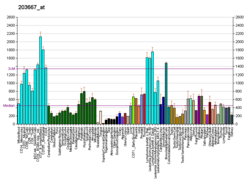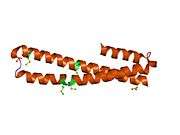Tubulin-specific chaperone A is a protein that in humans is encoded by the TBCA gene.[5][6][7]
The product of this gene is one of four proteins (cofactors A, D, E, and C) involved in the pathway leading to correctly folded beta-tubulin from folding intermediates. Cofactors A and D are believed to play a role in capturing and stabilizing beta-tubulin intermediates in a quasi-native confirmation. Cofactor E binds to the cofactor D/beta-tubulin complex; interaction with cofactor C then causes the release of beta-tubulin polypeptides that are committed to the native state. This gene encodes chaperonin cofactor A.[7]
References
- 1 2 3 GRCh38: Ensembl release 89: ENSG00000171530 - Ensembl, May 2017
- 1 2 3 GRCm38: Ensembl release 89: ENSMUSG00000042043 - Ensembl, May 2017
- ↑ "Human PubMed Reference:".
- ↑ "Mouse PubMed Reference:".
- ↑ Mao M, Fu G, Wu JS, Zhang QH, Zhou J, Kan LX, Huang QH, He KL, Gu BW, Han ZG, Shen Y, Gu J, Yu YP, Xu SH, Wang YX, Chen SJ, Chen Z (Aug 1998). "Identification of genes expressed in human CD34+ hematopoietic stem/progenitor cells by expressed sequence tags and efficient full-length cDNA cloning". Proc Natl Acad Sci U S A. 95 (14): 8175–80. doi:10.1073/pnas.95.14.8175. PMC 20949. PMID 9653160.
- ↑ Tian G, Huang Y, Rommelaere H, Vandekerckhove J, Ampe C, Cowan NJ (Sep 1996). "Pathway leading to correctly folded beta-tubulin". Cell. 86 (2): 287–96. doi:10.1016/S0092-8674(00)80100-2. PMID 8706133.
- 1 2 "Entrez Gene: TBCA tubulin folding cofactor A".
Further reading
- Lewis SA, Tian G, Vainberg IE, Cowan NJ (1996). "Chaperonin-mediated folding of actin and tubulin". J. Cell Biol. 132 (1–2): 1–4. doi:10.1083/jcb.132.1.1. PMC 2120700. PMID 8567715.
- Zhang QH, Ye M, Wu XY, et al. (2001). "Cloning and Functional Analysis of cDNAs with Open Reading Frames for 300 Previously Undefined Genes Expressed in CD34+ Hematopoietic Stem/Progenitor Cells". Genome Res. 10 (10): 1546–60. doi:10.1101/gr.140200. PMC 310934. PMID 11042152.
- Guasch A, Aloria K, Pérez R, et al. (2002). "Three-dimensional structure of human tubulin chaperone cofactor A". J. Mol. Biol. 318 (4): 1139–49. doi:10.1016/S0022-2836(02)00185-7. PMID 12054808.
- Strausberg RL, Feingold EA, Grouse LH, et al. (2003). "Generation and initial analysis of more than 15,000 full-length human and mouse cDNA sequences". Proc. Natl. Acad. Sci. U.S.A. 99 (26): 16899–903. doi:10.1073/pnas.242603899. PMC 139241. PMID 12477932.
- Gerhard DS, Wagner L, Feingold EA, et al. (2004). "The Status, Quality, and Expansion of the NIH Full-Length cDNA Project: The Mammalian Gene Collection (MGC)". Genome Res. 14 (10B): 2121–7. doi:10.1101/gr.2596504. PMC 528928. PMID 15489334.
- Nolasco S, Bellido J, Gonçalves J, et al. (2005). "Tubulin cofactor A gene silencing in mammalian cells induces changes in microtubule cytoskeleton, cell cycle arrest and cell death". FEBS Lett. 579 (17): 3515–24. doi:10.1016/j.febslet.2005.05.022. PMID 15963512.
- Bruneel A, Labas V, Mailloux A, et al. (2006). "Proteomics of human umbilical vein endothelial cells applied to etoposide-induced apoptosis". Proteomics. 5 (15): 3876–84. doi:10.1002/pmic.200401239. PMID 16130169.
PDB gallery |
|---|
1h7c: HUMAN TUBULIN CHAPERONE COFACTOR A |






